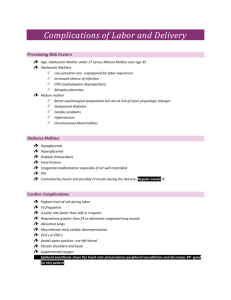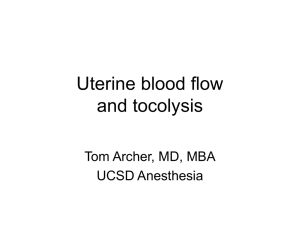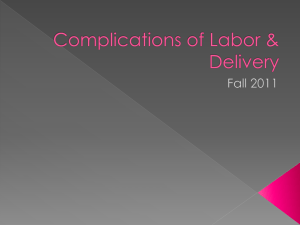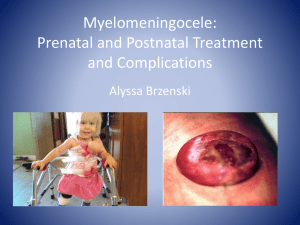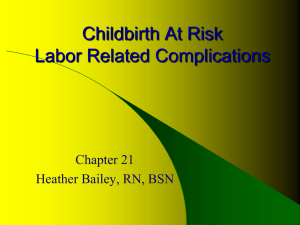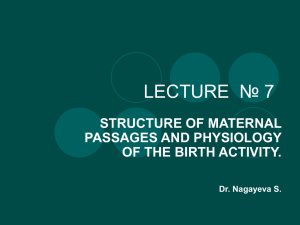The Women Who Develops a Complication During Labor and Birth
advertisement
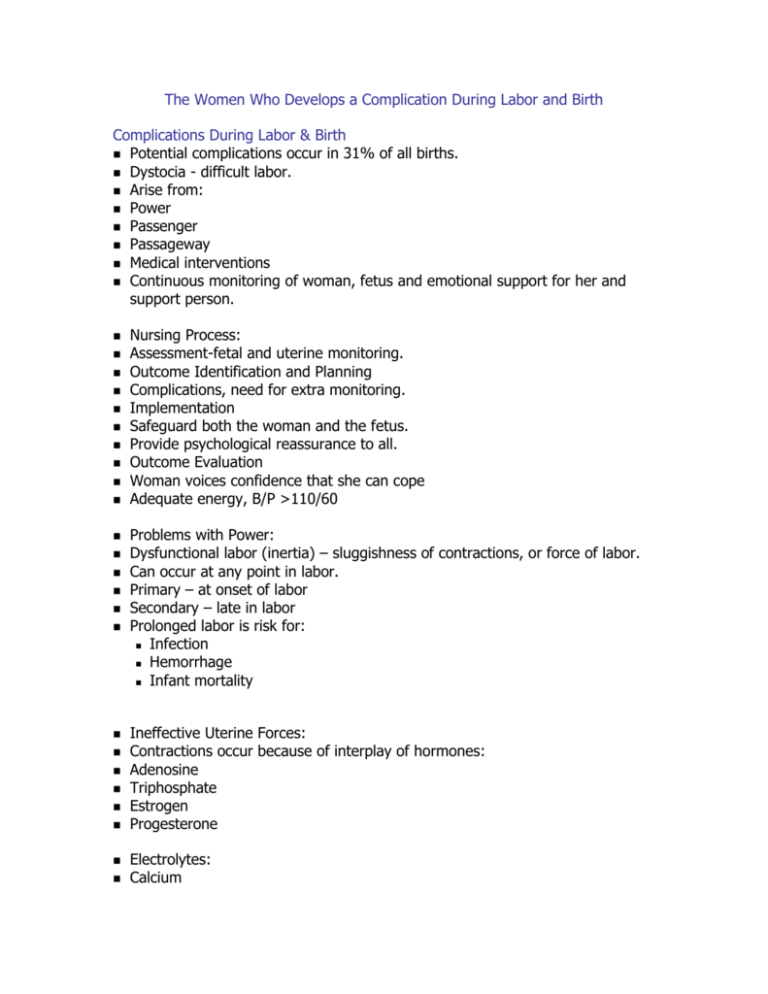
The Women Who Develops a Complication During Labor and Birth Complications During Labor & Birth Potential complications occur in 31% of all births. Dystocia - difficult labor. Arise from: Power Passenger Passageway Medical interventions Continuous monitoring of woman, fetus and emotional support for her and support person. Nursing Process: Assessment-fetal and uterine monitoring. Outcome Identification and Planning Complications, need for extra monitoring. Implementation Safeguard both the woman and the fetus. Provide psychological reassurance to all. Outcome Evaluation Woman voices confidence that she can cope Adequate energy, B/P >110/60 Problems with Power: Dysfunctional labor (inertia) – sluggishness of contractions, or force of labor. Can occur at any point in labor. Primary – at onset of labor Secondary – late in labor Prolonged labor is risk for: Infection Hemorrhage Infant mortality Ineffective Uterine Forces: Contractions occur because of interplay of hormones: Adenosine Triphosphate Estrogen Progesterone Electrolytes: Calcium Sodium Potassium Proteins: Actin Myosin Epinepherine Norepinephrine Oxytocin Prostaglandins Electronic uterine monitoring, external or internal measures duration, strength, interval between contractions. Factors for prolonged labor: Hypotonic Contractions: Number of contractions low or infrequent 2-3 in 10 minutes Resting tone below 10mm Hg Strength not above 25mm Hg During active phase When analgesia given too early (before dilatation of 3-4 cm) or bowel or bladder distension. Overstretched uterus Large fetus, hydramnios, lax uterus. Increase length of labor (more are needed for dilatation) Risk of postpartal hemorrhage, infection. IV oxytocin to strengthen contractions and increase effectiveness. Rupture membranes to speed labor. Hypertonic Contractions: Increase in resting tone > 15mm Hg. Occur frequently Latent phase of labor Muscle fibers of myometrium do not repolarize after a contraction. More than one pacemaker is stimulating contractions. Painful due to lack of relaxation and anoxia to uterine cells. Breathing does not relieve pain. Apply uterine and fetal monitor.(15 min.) Tx.-rest, morphine, change linen and gown, dark room, decrease noise and stimulation. May need cesarean section. Uncoordinated Contractions: Normal – one pacemaker point, contraction sweeps over uterus encircling it, repolarization occurs, low resting tone is achieved, another pacemaker activated contraction begins. More than one pacemaker initiating contractions or Receptor points in myometrium are acting independently of the pacemaker. One on top of another, erratic, long periods without any. External monitor: Rate, pattern, resting tone, fetal response to contractions.(15 minutes) Oxytocin Dysfunctional Labor and Associated Stages of Labor Anxiety, fear, and discouragement. Dysfunction at First Stage of Labor Prolonged Latent Phase: Longer than 20 hours in nullipara Longer than 14 hours in multipara Cervix not ripe at beginning of labor Excessive use of analgesics early in labor Hypertonic state Relaxation between contractions inadequate Mild contractions, ineffective (<15mm Hg) One segment of uterus contracts more force than another segment. Tx.- rest, fluids, morphine. Cesarean section or amniotomy and oxytocin infusion. Protracted Active Phase: Associated with cephalopelvic disproportion (CPD) or fetal malposition or ineffective myometrial activity. Prolonged if cervical dilatation does not occur at a rate of: 1.2 cm/hr or more in nullipara 1.5 cm/hr or more in multipara If active phase lasts over 12 hr in primigravida If active phase lasts over 6 hr in multigravida May need cesarean birth Hypotonic Oxytocin to augment labor Prolonged Deceleration Phase: Extends beyond 3 hr in nullipara Extends beyond 1 hr in multipara Abnormal fetal head position Cesarean birth. Secondary Arrest of Dilatation: No progress in cervical dilatation for > 2 hr Prolonged Descent: Rate of descent < 1.0 cm/hr in nullipara Descent rate < 2.0cm/hr in multipara Contractions become infrequent and poor quality, and dilatation stops R/O CPD or poor fetal presentation by sonogram Tx. –rest, fluids, rupture membranes, IV oxytocin, semi-fowlers position, squatting, kneeling, or more effective pushing. Dysfunction at the Second Stage of Labor Arrest of Descent: No descent for 1 hr in multipara No descent for 2 hr in nullipara No engagement or movement beyond 0 station. CPD Cesarean birth or Oxytocin to assist labor Nursing assessment and interventions: Glucose stores – OJ or IV, lollipops or hard candy to suck on during labor Stress – give support, ask about concerns Pain – breath with woman, back rubs, change sheets, cool washcloths, aromatherapy, music. Lie on left side Void q 2 hr. Contraction Rings: Simple type – can occur at any point in myometrium and anytime during labor. Pathologic retraction (Bandl’s ring)- most common, occurs at juncture of upper and lower uterine segments. Warning sign of dysfunctional labor Appears late in 2nd stage of labor Horizontal indentation across abdomen. Caused by excessive retraction of upper uterine segment. In early labor-due to uncoordinated contractions (obstetric manipulation or oxytocin) Fetus is gripped by retraction ring and cannot advance beyond that point. Sonogram IV morphine or inhalation of amyl nitrite Uterine rupture or fetal death can occur Also will grip the placenta Hemorrhage. Cesarean birth Precipitate Labor: Labor completed in < 3 hr. In active phase dilatation > 5cm/hr (1cm every 12 min) in nullipara or >10cm/hr (1 cm every 6 min) in multipara Occurs with multipara, induction of labor by oxytocin or amniotomy. Risks: hemorrhage, lacerations. Prepare multipara to leave early for hospital Uterine Rupture: Rare (1 in 1500 births) Vertical scar from cesarean, prolonged labor, faulty presentation, multiple gestation, unwise use of oxytocin, obstructed labor, and traumatic maneuvers using forceps or traction. Preceded by pathologic retraction ring and strong contractions without dilatation. With rupture a sudden severe pain, tearing feeling then pain stops. Hemorrhage, shock, change in contour of abdomen, FHR absent, changes in VS Emergency: cesarean immediately, IV fluid and oxytocin, may need a hysterectomy, mother and/or fetus in extreme jeopardy. Emotional period, fear, consents need to be obtained, anger and grief. Inversion of the Uterus: Uterus turns inside out. Rare (1 in 15000 births) Occurs when pressure is applied to uterine fundus. Degrees: may lie within the uterine cavity or vagina or protrude from the vagina. Large amount of blood suddenly gushes from the vagina. Fundus is not palpable in abdomen. Bleed to death in 10 min. Tx. VS, IV fluid, O2, CPR, general anesthesia or NTG or tocolytic to relax uterus, MD will replace fundus manually. Amniotic Fluid Embolism: Amniotic fluid is forced into an open maternal uterine blood sinus through some defect in membranes or after membrane or separation of the placenta. Humoral or anaphylactoid response. Occurs during labor or postpartal period. (1 in 8000 births) Risk factors-oxytocin, abrupto placentae and hydramnios. Dramatic picture: Strong labor, woman sits up suddenly grasps her chest due to sharp pain, and cannot breathe. Pale, bluish gray. Secondary to pulmonary artery constriction Tx.- O2, CPR(may not work) death in minutes. Prognosis depends on size of embolism and speed of Tx. DIC, cesarean birth. Problems with the Passenger Birth complications arise from: Undersized pelvis, altered bone growth, cord prolapse, more than 1 fetus, fetus too large or malpositioned in birth canal. Prolapse of the Umbilical Cord: (figure21.5) A loop of umbilical cord slips down in front of presenting fetal part. Occurs anytime after membranes rupture if presenting part not fitted firmly into cervix. Incidence 0.2 to 0.6% of births Occurs with: Premature rupture of membranes Fetal presentation other than cephalic Placenta previa Intreuterine tumors preventing the presenting part from engaging Small fetus Cephalopelvic disproportion preventing firm engagement Hydramnios Multiple gestation Assess: cord felt or visualized, FHR has variable deceleration, seen on sonogram. Tx.- relieve pressure on cord, manually elevating fetal head off the cord, kneechest or Trendelenburg position, O2 10L/min by facemask, tocolytic agent. If exposed to room sir do not push back cover with sterile saline compresses to prevent drying. Deliver immediately. (forcep or cesarean) Multiple Gestation: Excitement, extra staff, woman comes in early or scheduled cesarean, labor seems longer due to early admission. 2 FHR monitors, multiple risk factors. 1st fetus usually presents vertex, both ends of baby’s cord is clamped permanently. Sonogram to determine presentations. Placenta may separate before 2nd fetus is born and profuse bleeding occurs. Problems With Position, Presentation, Size Occipitoposterior Position: 1/10th of all labors (prolongs labor) ROP, LOP Internal rotation is 135 degrees. Woman has android, anthropoid, or contracted pelves. Presenting head does not fit cervix snugly. Risk of cord prolapse, sacral nerve pain, May need Cesarean birth. Breech Presentation: Most fetuses are in breech presentation early in pregnancy, by 38 wk it turns to cephalic. Risks: Anoxia from prolapsed cord Traumatic injury to the aftercoming head Fracture of spine or arm Dysfunctional labor Early rupture of membranes occurs due to poor fit of presenting part. Meconium FH heard high in abdomen, ultrasound, Leopold’s maneuver and exam are used. Dangers: Birth of head most hazardous Intracranial hemorrhage, pressure changes instantaneously. Forceps delivery Baby retains delivery position for 2-3 days. Face Presentation: Asynclitism-fetal head presenting at a different angle than expected. Sonogram to confirm Long 1st stage May have facial edema Brow Presentation: Rarest presentation Head becomes jammed in brim of pelvis as occipitomental diameter presents. Infant has extreme ecchymotic bruising on face. May need cesarean birth. Transverse Lie: Uterus is more horizontal than vertical. Leopold’s maneuver detects. Sonogram to confirm. Cesarean birth is necessary. Oversized Fetus (Macrosomia) > 9 to 10 lbs (4000 to 4500g) Diabetic mother, or multiparity. Pelvimetry or sonogram to compare fetal size with woman’s pelvic capacity. Wide shoulders may pose a problem. Large size of the fetus may be missed in a obese woman. Risks: cervical nerve palsy, diaphragmatic nerve injury, or fractured clavicle and postpartal hemorrhage due to uterus not contracting readily. Shoulder Dystocia: Occurs in 2nd stage of labor when fetal head is born but shoulders are too broad to enter and be delivered through pelvic outlet. (turtle sign) Risk-vaginal or cervical tears, cord compression, fx. clavical, brachial plexus injury. McRobert’s maneuver-woman flex thighs sharply on abdomen, widens pelvic outlet. Fetal Anomalies: Problems With The Passage Happens at the inlet, midpelvis, or the outlet. Inlet Contraction: Narrowing of the anteroposterior diameter to < 11 cm or maximum transverse diameter of 12 cm or less. Larger than usual head or smaller pelvis. Primigravida measurements recorded at 24 weeks of pregnancy. If the head engages it will probably pass. Outlet Contraction: Narrowing of transverse diameter at the outlet to < 11 cm. this is distance between ischial tuberosities. Made during prenatal visits. Trial Labor: Continues as long as descent of presenting part and dilatation of cervix are occurring. Monitor FHR, empty bladder, comfort. 6 to 12 hours no progress due cesarean birth External Cephalic Version: Turning of a fetus from a breech to a cephalic position before birth. Procedure: Monitor FHR and do ultrasound constantly. Tocolytic agent given, breech and vertex of fetus are located and grasped transabdominally by examiner’s hands on woman’s abdomen. Gentle pressure is exerted to rotate the fetus forward direction to a cephalic lie. Therapeutic Management of Problems Induction and Augmentation of Labor: Induction-labor is artificially started. Augmentation-assisting labor that has started spontaneously to be more effective. When contractions are ineffective, fetus is in danger, preeclampsia, eclampsia, hypertension, diabetes, Rh sensitization, prolonged ROM, intrauterine growth restriction, postmaturity >42 wk. Conditions must be present: Fetus in longitudinal lie Cervix is ripe, or ready for birth Presenting part engaged No cephalopelvic disproportion Fundus estimated to be mature by date, demonstrated by lecithinsphingomyelin ratio or sonogram biparietal diameter to R/O preterm birth. Cervical Ripening: Change in cervical consistency from firm to soft. 1st step uterus must complete. 8 or more ready for birth To ripen cervix: Stripping membranes Hygroscopic suppositories(seaweed suppositories swell on contact with cervical secretions) held in place by gauze sponge saturated with iodine or antifungal cream. Prostaglandin gel (Cytotec) by catheter or suppository or in a diaphragm against the cervix q 6 hr. Side effects- vomiting, diarrhea, hypertension. Oxytocin induction can be started in 6 to 12 hours. Induction of Labor by Oxytocin: Synthetic form of pituitary hormone to initiate contractions. (Pitocin or Syntocinon) IV so it can be D/C quickly. Half life 3 min. Dose 10 IU in 1000 mL of Ringer’s /MD Rate 0.5mU/min to1 mU/min Increased by 1 to 2 mU q 15 to 60 min. Give piggy back; use port nearest to pt. VS q 15 min., contractions no more than q 2 min, strength 50mm Hg, length 70 sec. If above stop infusion and call MD O2,Brethine to decrease myometrial activity Observe for water intoxication, I&O Predisposes newborn to hyperbilirubinemia and jaundice. Augmentation by Oxytocin: When contractions become weak, irregular or ineffective. Same as for primary induction of labor. Active Management of Labor: Aggressive administration of oxytocin > 6 mU/min rather than 1 to2 mU to shorten labor to 12 hours. (up to 36 to 40mU/min) Forceps Birth: Steel instruments constructed of 2 blades that slide together at shaft to form handles. Prevents pressure from being exerted on fetal head and aids in birth. Forceps are applied after fetal head reaches the perineum. Low forceps birth- + 2 station or more Midforceps birth – engaged but less than + 2 station (associated with birth trauma). Leads to increased urinary stress incontinence in women. Conditions: Woman unable to push with contractions Cessation of progress in 2nd stage of labor Fetus is in abnormal position or is immature. Need a pudental block to relax pelvis and reduce pain. Also an episiotomy is used. Before applied: Ruptured membranes. Cephalopelvic disproportion not present. Cervix fully dilated Bladder empty Record FHR before procedure and after. Assess cervix for lacerations, record 1st voiding, newborn marks will fade in 12 days. Vacuum Extraction: Fetal head is at perineum, a disk-shaped cup is pressed against fetal scalp over posterior fontanelle. When vacuum pressure is applied, air beneath the cup is sucked out and adheres tightly to fetal scalp and traction on the cord leading to the cup will deliver the fetus. Advantages – little anesthesia, fewer lacerations. Disadvantages – marked caput for 7 days. Anomalies of the Placenta and Cord Anomalies of the Placenta: 500 g and 15 to 20 cm diameter and 1.5 to 3.0 cm thick, 1/6th of wt of fetus. Enlarged with diabetes, syphilis, erythroblastosis. If uterus is scared the diameter will be wider. Placenta Succenturiata: Has one or more accessory lobes connected to main placenta by blood vessels. May appear torn at the edge or torn blood vessels. Small lobes may remain in uterus leading to hemorrhage. Placenta Circumvallata: Fetal side of placenta is covered to some extent with chorion. Battedore Placenta: Cord is inserted marginally rather than centrally. Velamentous Insertion of the Cord: Instead of cord entering placenta directly it separates into small vessels that reach the placenta by spreading across a fold of amnion (seen in multiple pregnancy). Vasa Previa: Umbilical vessels of a velamentous cord insertion cross the cervical os, so they deliver before fetus. May tear with dilatation Sonogram confirms Cesarean birth Placenta Accreta: Unusually deep attachment of placenta to uterine myometrium. Placenta will not loosen and deliver. Attempts to remove lead to hemorrhage. Hysterectomy or tx. with methotrexate to destroy the tissue. Anomalies of the Cord Two-Vessel Cord: Inspect cord immediately, drying distorts the appearance. Observe for anomalies- congenital heart and kidney and other mesoderm germ layer structures. Unusual Cord Length: Short-premature separation of placenta or abnormal fetal lie. Long-twists or knots more. Wraps around fetal neck.
